1. Bleeker-Rovers CP, van der Meer JWM. Fever of unknown origin. In : Kasper DL, Hauser SL, Jameson JL, editors. Harrison's Principles of Internal Medicine. 19th ed. New York, NY, USA: McGraw-Hill;2015. p. 135–142.
2. Vanderschueren S, Del Biondo E, Ruttens D, Van Boxelaer I, Wauters E, Knockaert DD. Inflammation of unknown origin versus fever of unknown origin: two of a kind. Eur J Intern Med. 2009; 20(4):415–418. PMID:
19524186.

3. Horowitz HW. Fever of unknown origin or fever of too many origins? N Engl J Med. 2013; 368(3):197–199. PMID:
23323894.

4. Takeuchi M, Dahabreh IJ, Nihashi T, Iwata M, Varghese GM, Terasawa T. Nuclear imaging for classic fever of unknown origin: meta-analysis. J Nucl Med. 2016; 57(12):1913–1919. PMID:
27339873.

5. Bharucha T, Rutherford A, Skeoch S, Alavi A, Brown M, Galloway J, et al. Diagnostic yield of FDG-PET/CT in fever of unknown origin: a systematic review, meta-analysis, and Delphi exercise. Clin Radiol. 2017; 72(9):764–771. PMID:
28600002.
6. Schönau V, Vogel K, Englbrecht M, Wacker J, Schmidt D, Manger B, et al. The value of
18F-FDG-PET/CT in identifying the cause of fever of unknown origin (FUO) and inflammation of unknown origin (IUO): data from a prospective study. Ann Rheum Dis. 2018; 77(1):70–77. PMID:
28928271.
7. Wang Q, Li YM, Li Y, Hua FC, Wang QS, Zhang XL, et al.
18F-FDGPET/CT in fever of unknown origin and inflammation of unknown origin: a Chinese multi-center study. Eur J Nucl Med Mol Imaging. 2019; 46(1):159–165. PMID:
30099578.
8. Kubota K, Tanaka N, Miyata Y, Ohtsu H, Nakahara T, Sakamoto S, et al. Comparison of
18F-FDG PET/CT and
67Ga-SPECT for the diagnosis of fever of unknown origin: a multicenter prospective study in Japan. Ann Nucl Med. 2021; 35(1):31–46. PMID:
33037581.
9. Kouijzer IJE, Mulders-Manders CM, Bleeker-Rovers CP, Oyen WJG. Fever of unknown origin: the value of FDG-PET/CT. Semin Nucl Med. 2018; 48(2):100–107. PMID:
29452615.

10. Kubota K, Takeuchi M, Wang Q, Nakamoto Y. FDG-PET/CT in patients with inflammation or fever of unknown origin (IUO and FUO). In : Toyama H, Li Y, Hatazawa J, Huang G, Kubota K, editors. PET/CT for Inflammatory Diseases. Berlin/Heidelberg, Germany: Springer;2020. p. 43–55.
11. Li Y, Wang Q, Wang X, Li X, Wu H, Wang Q, et al. Expert consensus on clinical application of FDG PET/CT in infection and inflammation. Ann Nucl Med. 2020; 34(5):369–376. PMID:
32086761.

12. Crouzet J, Boudousq V, Lechiche C, Pouget JP, Kotzki PO, Collombier L, et al. Place of (18)F-FDG-PET with computed tomography in the diagnostic algorithm of patients with fever of unknown origin. Eur J Clin Microbiol Infect Dis. 2012; 31(8):1727–1733. PMID:
22735898.

13. Kim YJ, Kim SI, Hong KW, Kang MW. Diagnostic value of 18F-FDG PET/CT in patients with fever of unknown origin. Intern Med J. 2012; 42(7):834–837. PMID:
22805689.

14. Zheng YJ, Lv W, Pan QQ. Effect of 18F-FDG PET/CT on etiological diagnosis for fever of unknown origin (FUO). J Clin Oncol. 2013; 19(12):936–939.
15. Gafter-Gvili A, Raibman S, Grossman A, Avni T, Paul M, Leibovici L, et al. [18F]FDG-PET/CT for the diagnosis of patients with fever of unknown origin. QJM. 2015; 108(4):289–298. PMID:
25208896.

16. Singh N, Kumar R, Malhotra A, Bhalla AS, Kumar U, Sood R. Diagnostic utility of fluorodeoxyglucose positron emission tomography/computed tomography in pyrexia of unknown origin. Indian J Nucl Med. 2015; 30(3):204–212. PMID:
26170562.

17. Takeuchi M, Nihashi T, Gafter-Gvili A, García-Gómez FJ, Andres E, Blockmans D, et al. Association of 18F-FDG PET or PET/CT results with spontaneous remission in classic fever of unknown origin: a systematic review and meta-analysis. Medicine (Baltimore). 2018; 97(43):e12909. PMID:
30412093.
18. Tsuzuki S, Watanabe A, Iwata M, Toyama H, Terasawa T. Gallium citrate-67 single-photon emission computed tomography/computed tomography for localizing the foci of classic fever and inflammation of unknown origin: a retrospective study of diagnostic yield. Asia Ocean J Nucl Med Biol. 2021; 9(2):1–12. PMID:
33392343.
19. Durack DT, Street AC. Fever of unknown origin--reexamined and redefined. Curr Clin Top Infect Dis. 1991; 11:35–51. PMID:
1651090.
20. Robine A, Hot A, Maucort-Boulch D, Iwaz J, Broussolle C, Sève P. Fever of unknown origin in the 2000s: evaluation of 103 cases over eleven years. Presse Med. 2014; 43(9):e233–40. PMID:
24985921.

21. Boellaard R, Delgado-Bolton R, Oyen WJG, Giammarile F, Tatsch K, Eschner W, et al. FDG PET/CT: EANM procedure guidelines for tumour imaging: version 2.0. Eur J Nucl Med Mol Imaging. 2015; 42(2):328–354. PMID:
25452219.

22. Jamar F, Buscombe J, Chiti A, Christian PE, Delbeke D, Donohoe KJ, et al. EANM/SNMMI guideline for 18F-FDG use in inflammation and infection. J Nucl Med. 2013; 54(4):647–658. PMID:
23359660.
23. Delbeke D, Coleman R, Guiberteau M, Brown M, Royal H, Siegel B, et al. Procedure guideline for tumor imaging with 18F-FDG PET/CT 1.0. J Nucl Med. 2006; 47(5):885–895. PMID:
16644760.
24. Mulders-Manders CM, Engwerda C, Simon A, van der Meer JWM, Bleeker-Rovers CP. Long-term prognosis, treatment, and outcome of patients with fever of unknown origin in whom no diagnosis was made despite extensive investigation: a questionnaire based study. Medicine (Baltimore). 2018; 97(25):e11241. PMID:
29924054.
25. Kouijzer IJE, van der Meer JWM, Oyen WJG, Bleeker-Rovers CP. Diagnostic yield of FDG-PET/CT in fever of unknown origin: a systematic review, meta-analysis, and Delphi exercise. Clin Radiol. 2018; 73(6):588–589. PMID:
29567271.

26. Morris TP, White IR, Carpenter JR, Stanworth SJ, Royston P. Combining fractional polynomial model building with multiple imputation. Stat Med. 2015; 34(25):3298–3317. PMID:
26095614.

27. Grant SW, Collins GS, Nashef SAM. Statistical primer: developing and validating a risk prediction model. Eur J Cardiothorac Surg. 2018; 54(2):203–208. PMID:
29741602.

28. White IR, Royston P, Wood AM. Multiple imputation using chained equations: issues and guidance for practice. Stat Med. 2011; 30(4):377–399. PMID:
21225900.

29. Austin PC, Steyerberg EW. Events per variable (EPV) and the relative performance of different strategies for estimating the out-of-sample validity of logistic regression models. Stat Methods Med Res. 2017; 26(2):796–808. PMID:
25411322.

30. Kang L, Xu XJ, Fan Y, Wang RF, Ma C, Fu ZL, et al. Diagnostic value of fluorine-18 fluorodeoxyglucose positron emission tomography/computed tomography in fever of unknown origin. Beijing Da Xue Xue Bao Yi Xue Ban. 2015; 47(1):175–180. PMID:
25686352.
31. Fu LP, Hu P, Wang QS, Wu HB, Li LF. 18F-FDG PET/CT imaging for fever of unknown origin. Chin J Clin Infect Dis. 2010; 3(3):176–179.
32. Fu N, Gong L. Analysis of the diagnostic value of 18F-FDG PET/CT in fever of unknown origin. Clinical Focus. 2013; 28(5):519–521.
33. Kei PL, Kok TY, Padhy AK, Ng DC, Goh AS. [18F] FDG PET/CT in patients with fever of unknown origin: a local experience. Nucl Med Commun. 2010; 31(9):788–792. PMID:
20634769.

34. Sheng JF, Sheng ZK, Shen XM, Bi S, Li JJ, Sheng GP, et al. Diagnostic value of fluorine-18 fluorodeoxyglucose positron emission tomography/computed tomography in patients with fever of unknown origin. Eur J Intern Med. 2011; 22(1):112–116. PMID:
21238906.

35. Kubota K, Nakamoto Y, Tamaki N, Kanegae K, Fukuda H, Kaneda T, et al. FDG-PET for the diagnosis of fever of unknown origin: a Japanese multi-center study. Ann Nucl Med. 2011; 25(5):355–364. PMID:
21344168.

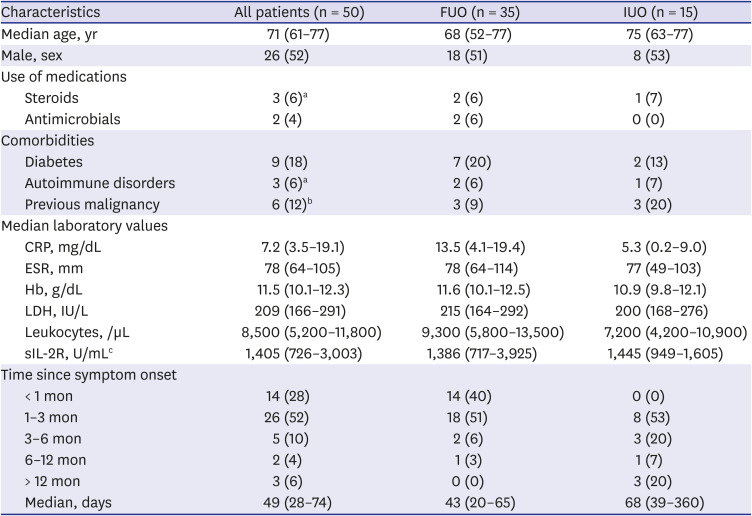
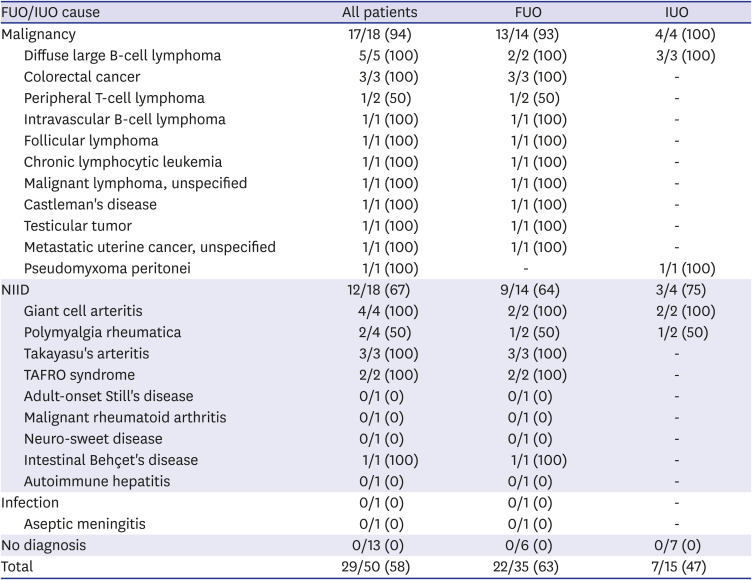

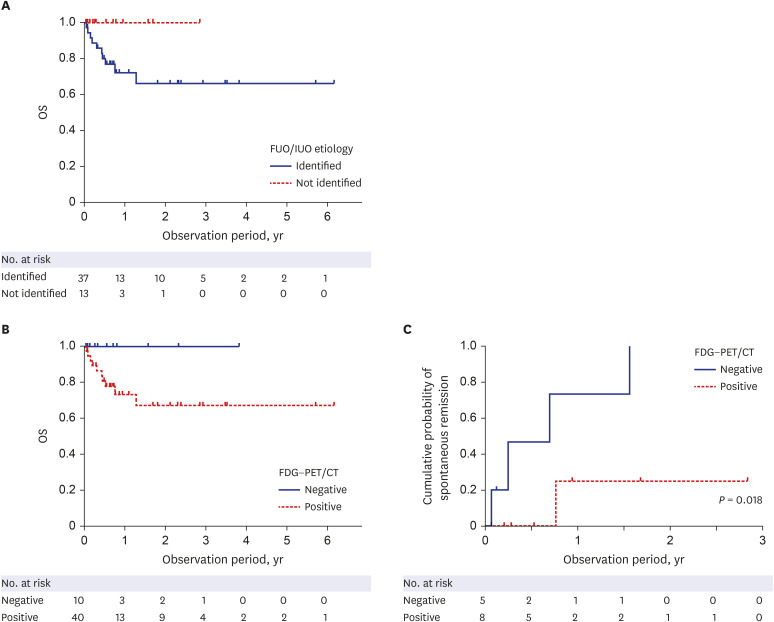




 PDF
PDF Citation
Citation Print
Print



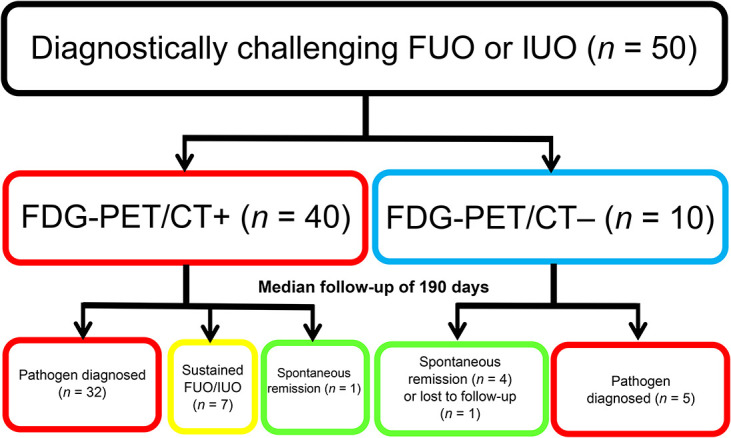
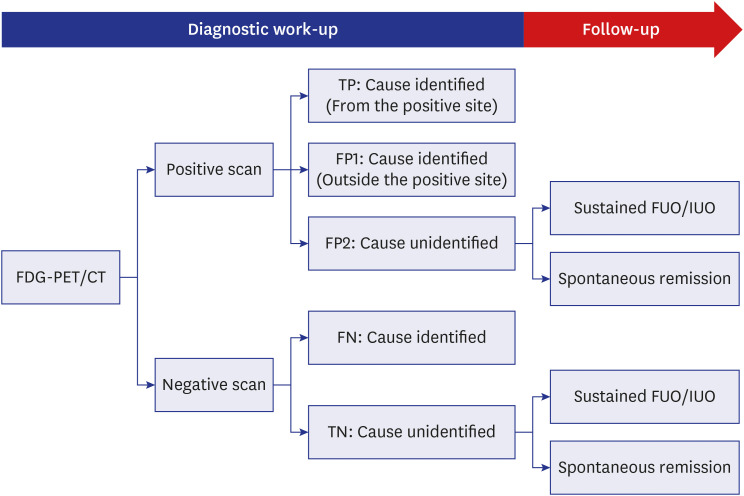
 XML Download
XML Download